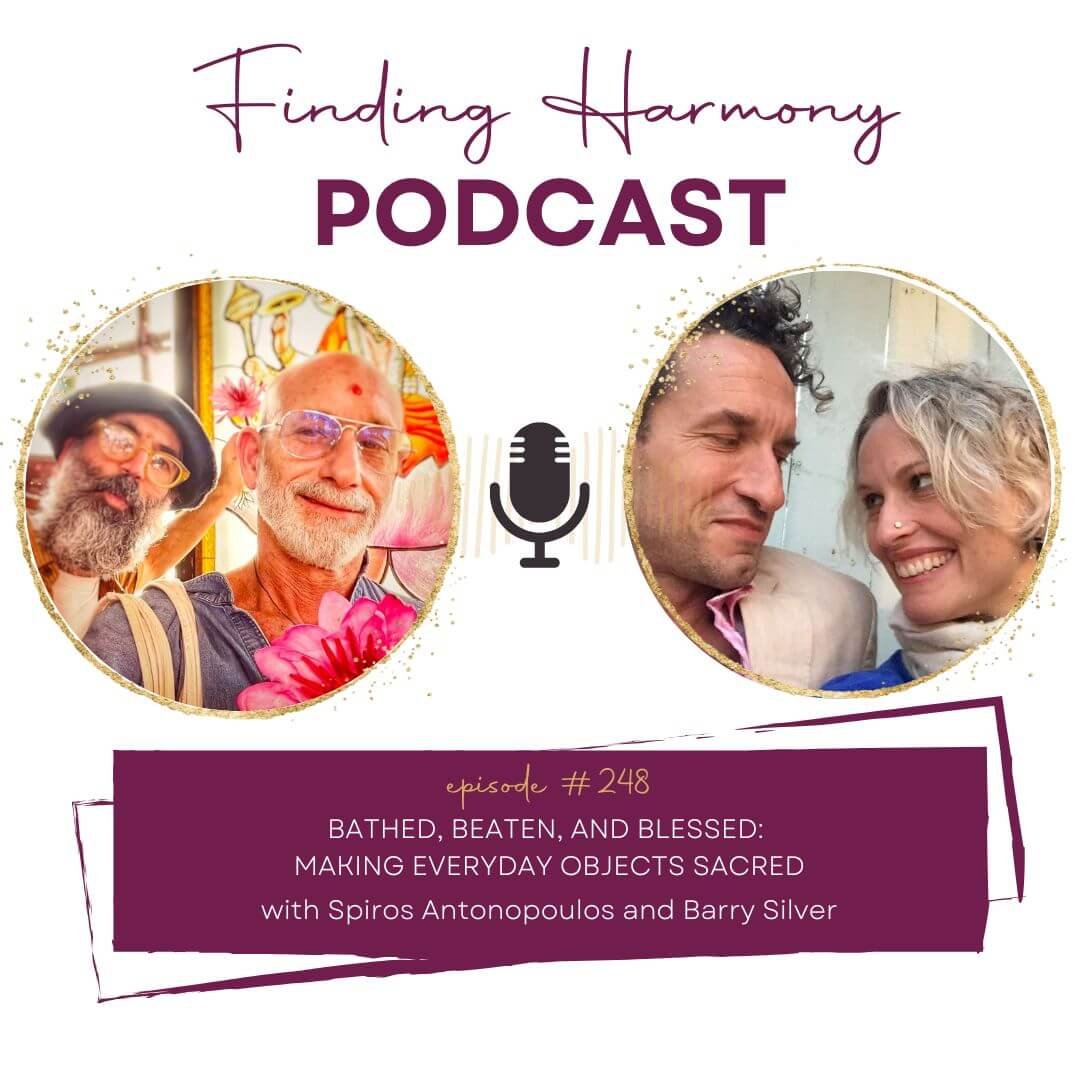Bathed, Beaten, and Blessed: Making Everyday objects sacred
Guests: Barry Silver & Spiros Antonopoulos
The Art of Consecration
It seems like everything today’s world is about speeding up, going faster, and keeping it disposable (or at least recyclable or compostable).
It's hard to wrap our heads around the idea of flying halfway around the world to participate in a series of rituals that transform ordinary objects into sacred talismans!
Yet, this is precisely what Spiros Antonopoulos and Barry Silver have set out to do with their project: Gently Down: Bathed, Beaten, and Blessed.
This week on the Finding Harmony Podcast, we sat down with Spiros and Barry to reframe how we engage with the regular objects in our lives, and learn how to infuse more intention, ritual, and meaning into the simple things we do each and every day.
At the heart of their project is the practice of consecration—a timeless ritual of transforming the ordinary into the extraordinary, the mundane into the miraculous.
But what does consecration really mean, and how can we apply it in our own lives?
Consecration is the act of dedicating something to a higher purpose, imbuing it with spiritual significance. In many traditions, this process involves a ritual or series of actions designed to cleanse, purify, and bless an object, space, or even a state of mind.
Whether it’s a t-shirt bathed in the holy waters of the Ganges or a moment of silence before a meal, consecration is an intentional act that transforms how we perceive and interact with the world.
For Spiros and Barry, consecration involves taking everyday items—like their custom-made t-shirts—and subjecting them to sacred rituals. The shirts are bathed in the Ganges River, beaten clean of impurities, and blessed in temple ceremonies, becoming talismans that carry the energy of these transformative actions.
In a time when so much of our attention is fractured by endless scrolling, notifications, and multitasking, the practice of consecration asks us to pause. It encourages us to see the divine in the mundane and to bring intention into even the smallest aspects of our lives.
While not everyone has the opportunity to take their belongings to the Ganges, participate in the Kumbh Mela, or consult with Vedic temple priests, the principles of consecration can be adapted to everyday life.
Here are a few simple steps to ignite this power yourself:
Set Intentions: Before starting any task—yoga, cooking, writing, or even getting dressed—pause for a moment and set an intention. (ex. dedicate your morning coffee ritual to savoring the moment)
Create Personal Rituals: Rituals don’t have to be elaborate. Lighting a candle before beginning your yoga practice, saying a mantra before eating, or even folding laundry with care can transform routine actions into sacred moments.
Infuse Meaning into Objects: Could your journal become a vessel for manifestation? Could your favorite mug remind you to savor life’s small joys? By ascribing meaning to some of your favorite objects, you create talismans of your own.
Practice Gratitude: Acknowledge the interconnectedness of all things. Whether it’s the farmer who grew your food or the hands that sewed your clothes, recognizing the effort and energy behind everyday objects fosters a greater sense of reverence and connection.
Alchemy of the Heart
As Spiros and Barry demonstrate, consecration is not just about the objects—it’s about us.
It’s a mirror reflecting our own potential for transformation.
Just as the Ganges cleanses and purifies, the act of consecration cleanses the heart, making space for new intentions, renewed energy, and deeper connections.
Ultimately, consecration is an invitation to slow down, to observe, and to honor the sacredness of life. It reminds us that the divine is not something far off and unattainable but something we can find gently down the stream of our everyday experiences.
You can participate in the Gently Down Project and order your own consecrated alter medallion, t-shirt, holy water + rudraksha set:
Move your practice beyond your asana practice. Join us inside the Finding Harmony Community to deepen your understanding of yoga and continue these important conversations!
Join the Finding Harmony Community!
LEARN MORE ABOUT GENTLY DOWN PROJECT
INSTAGRAM I WEBSITE I SPIROS IG I BARRY IG
Work With Harmony:
Follow the Finding Harmony Podcast on IG
Two Minute Breathwork Session
Subscribe and Stay Tuned:
Don't miss our upcoming episodes, where we continue to explore the fascinating intersections of yoga, health, and science!
Listen Now…
The Finding Harmony Podcast is hosted, edited and produced by Harmony Slater and co-hosted by Russell Case.
A big heart of thanks to our friends, family, and students from around the world, who’ve generously supported this podcast through your comments, sharing, and financial donations.
Your contributions have allowed us to keep our podcast ad and sponsor free. Creating, editing and producing each episode takes a lot of time. It is a labor of love. And would not be possible without your kind support.
If you’ve enjoyed today’s podcast, please consider supporting our future episodes by making a donation. Every little bit goes a long way and we are immensely grateful for any and all of your support.
Don’t forget to subscribe and leave a review! ❤
Give us a 5★ rating!
We love to read and respond to your comments - So drop us a note in the comments below and give us a shout out on IG!
Opening and closing music compliments of my dear friend teaching Ashtanga yoga in Eindhoven, Nick Evans, with his band “dawnSong” from the album “for Morgan.” Listen to the entire album on Spotify - Click Here.
To purchase your own copy - Click Here.




